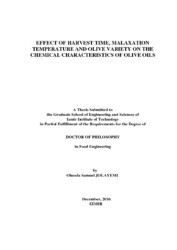Please use this identifier to cite or link to this item:
https://hdl.handle.net/11147/5732Full metadata record
| DC Field | Value | Language |
|---|---|---|
| dc.contributor.advisor | Tokatlı, Figen | - |
| dc.contributor.advisor | Özen, Fatma Banu | - |
| dc.contributor.author | Jolayemi, Olusola Samuel | - |
| dc.date.accessioned | 2017-06-09T12:48:20Z | - |
| dc.date.available | 2017-06-09T12:48:20Z | - |
| dc.date.issued | 2016-12 | - |
| dc.identifier.citation | Jolayemi, O. S. (2016). Effect of harvest time, malaxation tempetature and olive variety on the chemical characteristics of olive oils. Unpublished doctoral dissertation, İzmir Institute of Technology, İzmir, Turkey | en_US |
| dc.identifier.uri | http://hdl.handle.net/11147/5732 | - |
| dc.description | Thesis (Doctoral)--Izmir Institute of Technology, Food Engineering, Izmir, 2016 | en_US |
| dc.description | Full text release delayed at author's request until 2019.12.05 | en_US |
| dc.description | Includes bibliographical references (leaves: 144-159) | en_US |
| dc.description | Text in English; Abstract: Turkish and English | en_US |
| dc.description | xviii, 169 leaves | en_US |
| dc.description.abstract | Changes in chemical and quality characteristics of olive oils were evaluated with respect to pre and post-harvest factors such as: olive type, harvest time, malaxation temperature, and storage at room temperature. Additionally, discriminative and predictive capacities of UV-vis, near infrared (NIR), mid infrared (MIR) spectra and electronic nose data on olive oils by using multivariate statistical tools were studied. Varietal and harvest time differences were the most significant factors influencing the quality and chemical properties of Ayvalik and Memecik olive oils. Malaxation temperature was significant on a number of phenolic compounds such as tyrosol, hydroxytyrosol and pinoresinol, and peroxide value. Olive oils of early and mid-harvest were higher in phenolic alcohols, and pigments content, whereas peroxide values, linoleic and stearic acids characterized late harvest oils. Storage for 15 months at room temperature in dark facilitated evolution of some important phenols, while increasing the content of ethyl and methyl esters at varying degrees among varieties. There were no significant changes in fatty acids and acidity contents of the oils. However, total phenol content and oxidative stability declined and a significant depletion of colors and pigments contents occurred. Multivariate regression analysis indicated that lipid-based variables are the most consistent contributors (positive or negative) to olive oil oxidative stability. UV-vis, MIR, NIR spectroscopies and e-nose data were excellent varietal and harvest season discriminating tools. Pigments were well predicted by UV-vis, while MIR performs better in the prediction of fatty acids, alkyl esters, oxidative stability and free fatty acid. | en_US |
| dc.description.abstract | Bu çalışmada, zeytin yağlarının kimyasal kompozisyonları ve kalite parametrelerindeki değişiklikler, zeytin tipi, hasat zamanı, malaksör sıcaklığı ve depolama zamanına göre incelenmiştir. Ayrıca, ultraviyole-görünür (UV-vis), yakın-kızılötesi (NIR), orta-kızılötesi (MIR) ve elektronik burun (e-burun) tekniklerinin yağ örneklerini sınıflandırma ve bazı kimyasal parametreleri tahminleme kapasiteleri çok değişkenli istatistiksel tekniklerle çalışılmıştır. Ayvalık ve Memecik zeytinyağlarının kimyasal ve kalite özelliklerinin farklılıklar gösterdiği ve bu değişkenlerin en fazla hasat zamanından etkilendiği tespit edilmiştir. Malaksiyon sıcaklığı bazı fenolik maddeler (tirosol, hidroksitirosol, pinoresinol) ve peroksit değeri üzerinde etkili bulunmuştur. Erken ve orta hasat dönemlerinde elde edilen yağlar fenolik alkoller ve klorofil, karoten pigmentleri açısından daha zenginken, geç hasat yağlarını karakterize eden parametreler yüksek peroksit değeri, linoleik ve stearik asit konsantrasyonları olarak bulunmuştur. Oda sıcaklığında ve karanlıkta 15 ay depolanan zeytinyağların toplam fenol, renk pigmenti konsantrasyonları ve oksidatif stabilitelerinde azalma, etil ve metil ester miktarlarında ise artış gözlenmiştir. Yağ asitleri kompozisyonlarında ve serbest asitlik değerlerinde istatistiki olarak önemli değişiklikler görülmemiştir. Fenolik maddelerden hidroksitirosol, tirosol ve pinoresinol konsantrasyonlarında artış tespit edilmiştir. UV-vis, MIR, NIR ve e-burun verileri zeytinyağlarının varyete ve hasat zamanına göre sınıflandırılmasında etkili olmuştur. Pigment konsantrasyonları UV-vis ile daha doğru tahmin edilirken, MIR, yağ asitleri, alkil esterleri, oksidatif kararlılık ve serbest yağ asidi parametrelerinin tahmininde daha iyi sonuçlar vermiştir. | en_US |
| dc.language.iso | en | en_US |
| dc.publisher | Izmir Institute of Technology | en_US |
| dc.rights | info:eu-repo/semantics/openAccess | en_US |
| dc.subject | Olive oil | en_US |
| dc.subject | Chemical characterization | en_US |
| dc.subject | Storage effect | en_US |
| dc.subject | Chemometrics | en_US |
| dc.title | Effect of Harvest Time, Malaxation Tempetature and Olive Variety on the Chemical Characteristics of Olive Oils | en_US |
| dc.title.alternative | Hasat Zamanı, Malaksör Sıcaklığı ve Zeytin Tipinin Sızma Zeytinyağlarının Kimyasal Özellikleri Üzerine Etkisi | en_US |
| dc.type | Doctoral Thesis | en_US |
| dc.institutionauthor | Jolayemi, Olusola Samuel | - |
| dc.department | Thesis (Doctoral)--İzmir Institute of Technology, Food Engineering | en_US |
| dc.request.email | solajolay@yahoo.com | - |
| dc.request.fullname | Olusola Samuel Jolayemi | - |
| dc.relation.publicationcategory | Tez | en_US |
| dc.identifier.wosquality | N/A | - |
| dc.identifier.scopusquality | N/A | - |
| item.languageiso639-1 | en | - |
| item.openairetype | Doctoral Thesis | - |
| item.grantfulltext | open | - |
| item.cerifentitytype | Publications | - |
| item.fulltext | With Fulltext | - |
| item.openairecristype | http://purl.org/coar/resource_type/c_18cf | - |
| Appears in Collections: | Phd Degree / Doktora | |
Files in This Item:
| File | Description | Size | Format | |
|---|---|---|---|---|
| T001567.pdf | DoctoralThesis | 3.9 MB | Adobe PDF |  View/Open |
CORE Recommender
Sorry the service is unavailable at the moment. Please try again later.
Items in GCRIS Repository are protected by copyright, with all rights reserved, unless otherwise indicated.